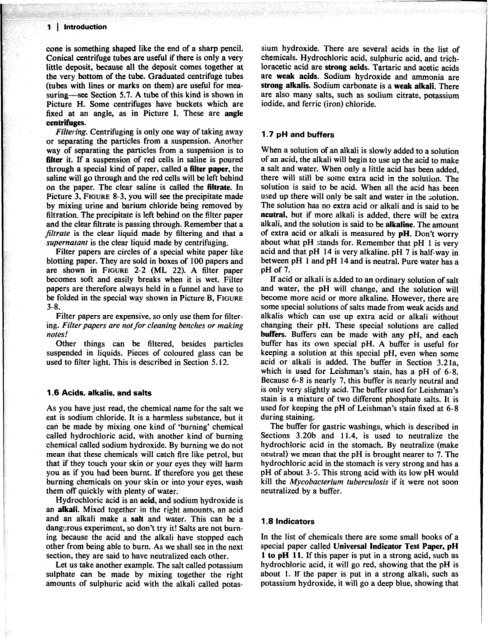MICROFICHE REFERENCE LIBRARY
MICROFICHE REFERENCE LIBRARY
MICROFICHE REFERENCE LIBRARY
You also want an ePaper? Increase the reach of your titles
YUMPU automatically turns print PDFs into web optimized ePapers that Google loves.
,::,, ,./’ I1 1 Introductioncone is something shaped like the end of a sharp pencil.Conical centrifuge tubes are useful if there is only a verylittle deposit, because all the deposit comes together atthe very bottom of the tube. Graduated centrifuge tubes(tubes with lines or marks on them) are useful for measuring-seeSection 5.7. A tube of this kind is shown inPicture H. Some centrifuges have buckets which arefixed at an angle, as in Picture I. These are anglecentrifuges.Filtering. Centrifuging is only one way of taking awayor separating the particles from a suspension. Anotherway of separating the particles from a suspension is tofilter it. If a suspension of red cells in saline is pouredthrough a special kind of paper, called a filter paper, thesaline will go through and the red cells will be left behindon the paper. The clear saline is called the filtrate. InPicture 3, FIGURE 8-3, you will see the precipitate madeby mixing urine and barium chloride being removed byfiltration. The precipitate is left behind on the filter paperand the clear filtrate is passing through. Remember that afiltrate is the clear liquid made by filtering and that asupernatant is the clear liquid made by centrifuging.Filter papers are circles of a special white paper likeblotting paper. They are sold in boxes of 100 papers andare shown in FIGURE 2-2 (ML 22). A filter paperbecomes soft and easily breaks when it is wet. Filterpapers are therefore always held in a funnel and have tobe folded in the special way shown in Picture B, FIGURE3-8.Filter papers are expensive, so only use them for filtering.Filter papers are not for cleaning benches or makingnotes!Other things can be filtered, besides particlessuspended in liquids. Pieces of coloured glass can beused to filter light. This is described in Section 5.12.1.6 Acids, alkalis, and saltsAs you have just read, the chemical name for the salt weeat is sodium chloride, It is a harmless substance, but itcan be made by mixing one kind of ‘burning’ chemicalcalled hydrochloric acid, with another kind of burningchemical called sodium hydroxide. By burning we do notmean that these chemicals will catch fire like petrol, butthat if they touch your skin or your eyes they will harmyou as if you had been burnt. If therefore you get theseburning chemicals on your skin or into your eyes, washthem off quickly with plenty of water.Hydrochloric acid is an acid, and sodium hydroxide isan alkali. Mixed together in the right amounts, an acidand an alkali make a salt and water. This can be adang!;rous experiment, so don’t try it! Salts are not burningbecause the acid and the alkali have stopped eachother from being able to burn. As we shall see in the nextsection, they are said to have neutralized each other.Let us take another example. The salt called potassiumsulphate can be made by mixing together the rightamounts of sulphuric acid with the alkali called potas-sium hydroxide. There are several acids in the list ofchemicals. Hydrochloric acid, sulphuric acid, and trichloraceticacid are strong acids. Tartaric and acetic acidsare weak acids. Sodium hydroxide and ammonia arestrong alkalis. Sodium carbonate is a weak alkali. Thereare also many salts, such as sodium citrate, potassiumiodide, and ferric (iron) chloride.1.7 pH and buffersWhen a solution of an alkali is slowly added to a solutionof an acid, the alkali will begin to use up the acid to makea salt and water. When only a little acid has been added,there will still be some extra acid in the solution. Thesolution is said to be acid. When all the acid has beenused up there will only be salt and water in the solution.The solution has no extra acid or alkali and is said to beneutral, but if more alkali is added, there will be extraalkali, and the solution is said to be alkaline. The amountof extra acid or alkali is measured by pH. Don’t worryabout what pH stands for. Remember that pH 1 is veryacid and that pH 14 is very alkaline. pH 7 is haif-way inbetween pH 1 and pH 14 and is neutral. Pure water has apH of 7.If acid or alkali is added to an ordinary solution of saltand water, the pH will change, and the solution willbecome more acid or more alkaline. However, there aresome special solutions of salts made from weak acids andalkalis which can use up extra acid or alkali withoutchanging their pH. These special solutions are calledbuffers. Buffers can be made with any pH, and eachbuffer has its own special pH. A buffer is useful forkeeping a solution at this special pH, even when someacid or alkali is added. The buffer in Section 3.2la,which is used for Leishman’s stain, has a pH of 6.8.Because 6.8 is nearly 7, this buffer is nearly neutral andis only very slightly acid. The buffer used for Leishman’sstain is a mixture of two different phosphate salts. It isused for keeping the pH of Leishman’s stain fixed at 6.8during staining.The buffer for gastric washings, which is described inSections 3.20b and 11.4, is used to neutralize thehydrochloric acid in the stomach. By neutralize (makeneutral) we mean that the pH is brought nearer to 7. Thehydrochloric acid in the stomach is very strong and has apH of about 3.5. This strong acid with its low pH wouldkill the Mycobacterium tuberculosis if it were not soonneutralized by a buffer.1.8 IndicatorsIn the list of chemicals there are some small books of aspecial paper called Universal Indicator Test Paper, pH1 to pH 11. If this paper is put in a strong acid, such ashydrochloric acid, it will go red, showing that the pH isabout 1. If the paper is put in a strong alkali, such aspotassium hydroxide, it will go a deep blue, showing that
















